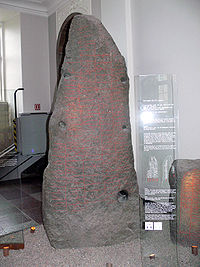Tryggevælde Runestone


Tryggevælde Runestone, designated as DR 230 under Rundata, is a runestone housed in the National Museum of Denmark, in Copenhagen. It is classified as being carved in runestone style RAK, and is dated to about 900 CE.
Description
In 1555, the runestone was moved from a barrow to the Tryggevælde estate on Zealand. It came to Copenhagen in 1810.[1]
There are several holes on the runestone, but no one knows why. Ragnhild, who raised the runestone, also had Glavendrup stone (DR 209) made after another husband named Alle. That runestone is located at a barrow and a stone ship in Glavendrup on the island of Funen. Both the Glavendrup and Tryggevælde runestones were made by the same runemaster, Sote.
The inscription ends with a curse against anyone who would destroy or move the runestone that is similar to the ones found on the Glavendrup stone the Sønder Vinge runestone 2 and the Glemminge stone and the Saleby Runestone in Sweden. There is some disagreement regarding the translation of one of the words in these curses, rita/rata, which has been translated as 'wretch,' 'outcast,' or 'warlock.'[2] Warlock is the translation accepted by Rundata. However, the use of warlock is not that the destroyer would gain any magical powers, but be considered to be unnatural and a social outcast.[3] The concept that being a warlock or sorcerer was an evil perversion predated the conversion of Scandinavia to Christianity.[3]
This inscription is the first mention of the Old Scandinavian ship type skeið.
Inscription
The lines:
- Transliteration of the runes into Latin characters
- Transcription into standardized Old Norse
- Transcription into standardized Old Danish
raknhiltr
Ragnhildr,
Ragnhildr,
'
sustiʀ
systir
systiʀ
'
ulfs
Ulfs,
Ulfs,
'
sati
setti
satti
'
stain
stein
sten
¶
þnnsi
þenna
þænsi
'
auk
ok
ok
'
karþi
gerði
gærþi
'
hauk
haug
høg
'
þonsi
þenna
þænsi
auft
ept,
æft,
¶
auk
ok
ok
skaiþ
skeið
skeþ
'
þaisi
þessa,
þæssi,
¶
kunulf
Gunnulf,
Gunulf,
'
uar
ver
wær
sin
sinn,
sin,
'
klomulan
glômulan
glamulan
man
mann,
man,
¶
(s)un
son
sun
'
nairbis
Nerfis.
Nærfis.
'
faiʀ
Fáir
Faiʀ
'
uarþa
verða
wærþa
'
nu
nú
nu
futiʀ
fœddir
føddiʀ
'
þoi
þeim
þem
batri
betri.
bætri.
Ragnhildr, Ulfr's sister, placed this stone and made this mound, and this ship(-setting), in memory of her husband Gunnulfr, a clamorous man, Nerfir's son. Few will now be born better than him.
sa
Sá
Sa
uarþi
verði
wærþi
'
at
at
at
(')
rita
réta(?)
ræta(?)
'
is
er
æs
ailti
elti(?)
ælti(?)
stain
stein
sten
þonsi
þenna
þænsi
A warlock(?) be he who damages(?) this stone
References
- ^ Danmark: Tryggevælde, Karise Socken Archived 2007-09-27 at the Wayback Machine (Swedish website).
- ^ Nielsen, M. L. (1998). "Glavendrup". In Hoops, Johannes; Beck, Heinrich (eds.). Reallexikon der Germanischen Altertumskunde. Vol. 12. Walter de Gruyter. p. 198. ISBN 3-11-016227-X.
- ^ a b MacLeod, Mindy; Mees, Bernard (2006). Runic Amulets and Magic Objects. Boydell Press. pp. 225–226. ISBN 1-84383-205-4.
- ^ Project Samnordisk Runtextdatabas Svensk - Rundata.
